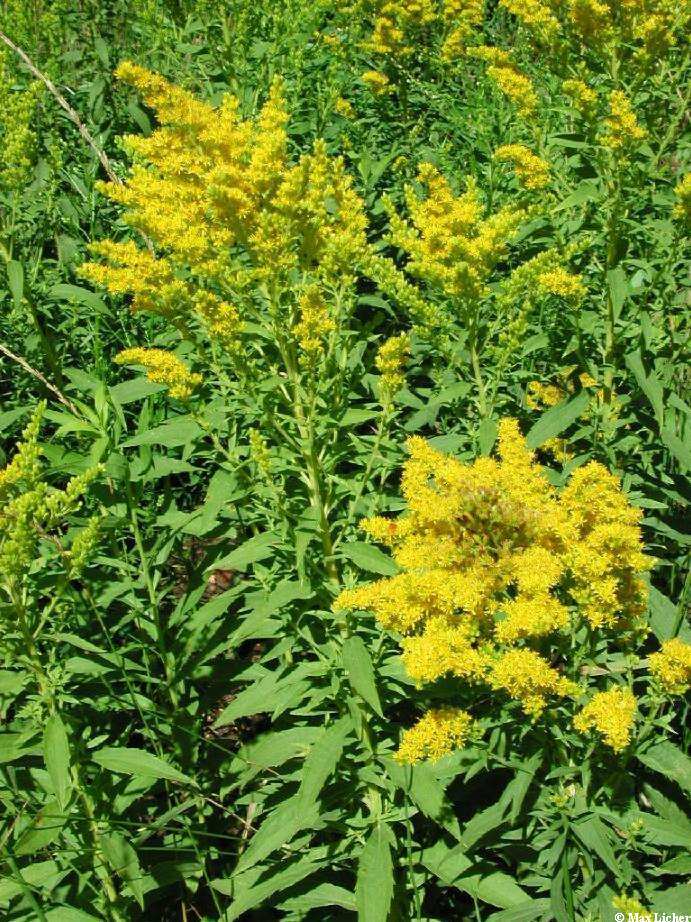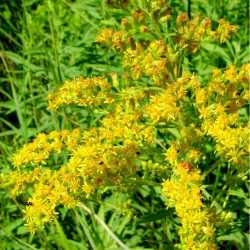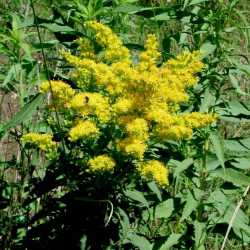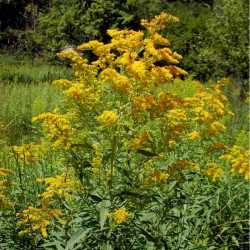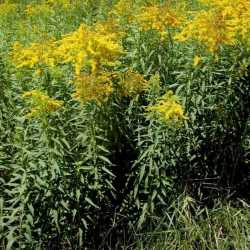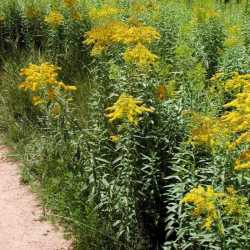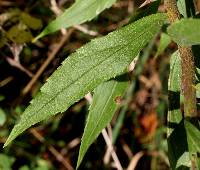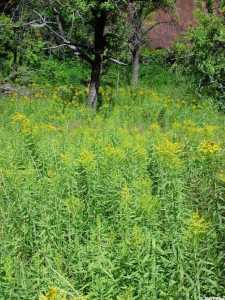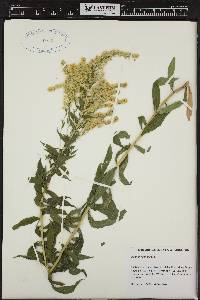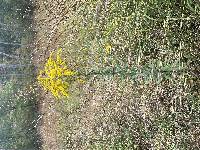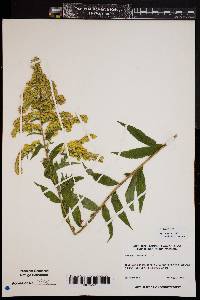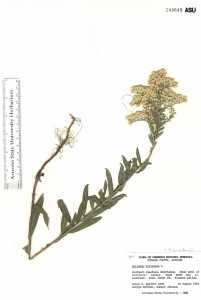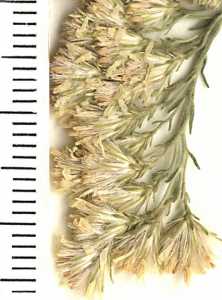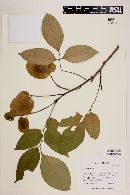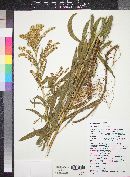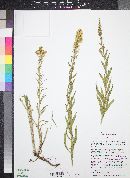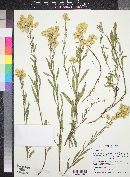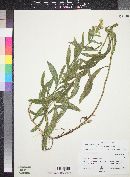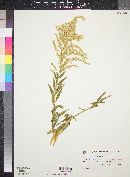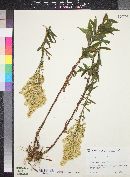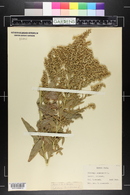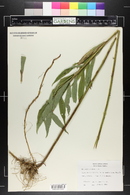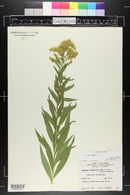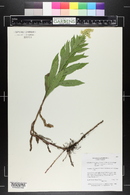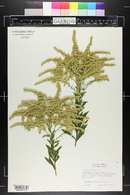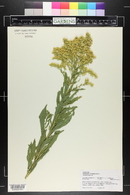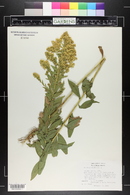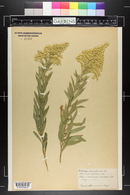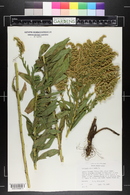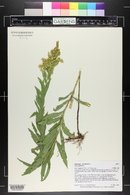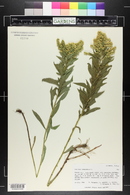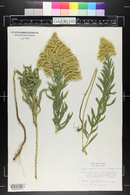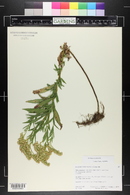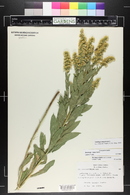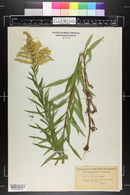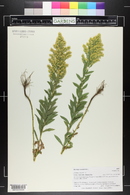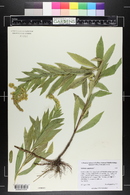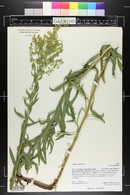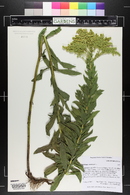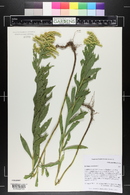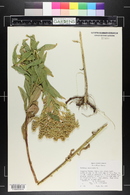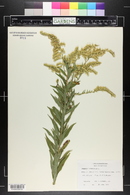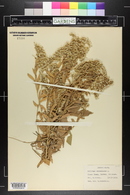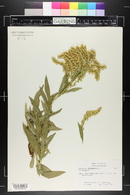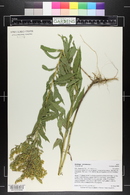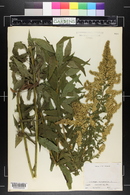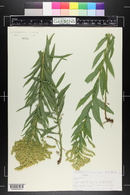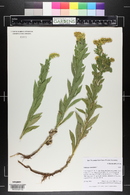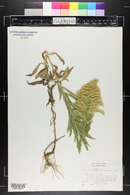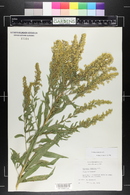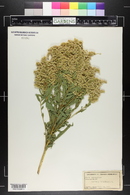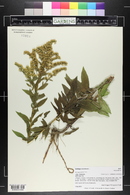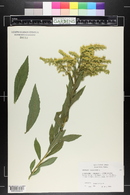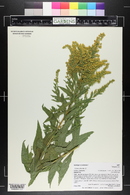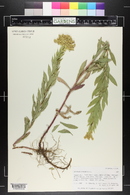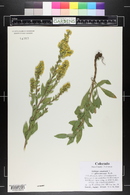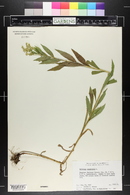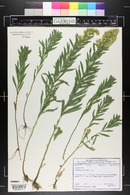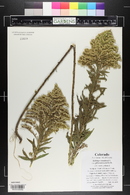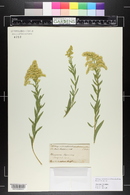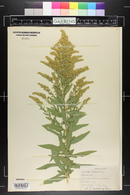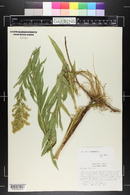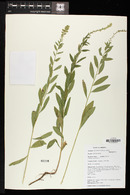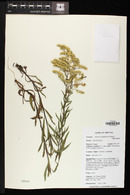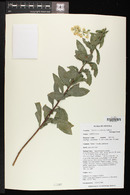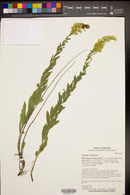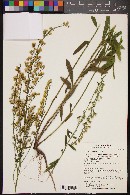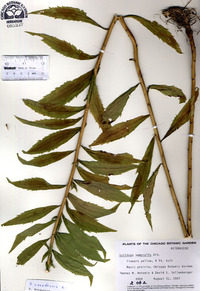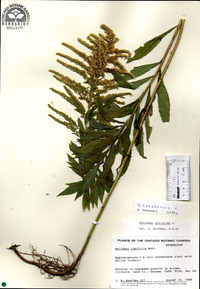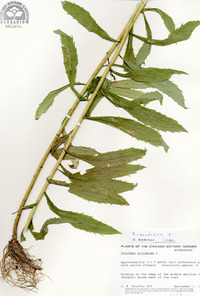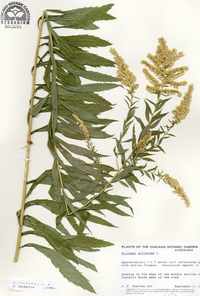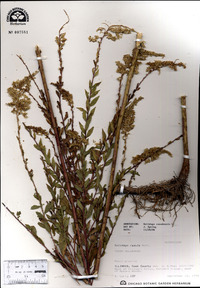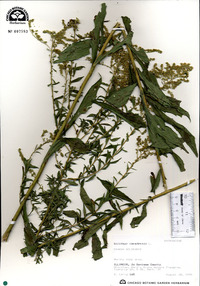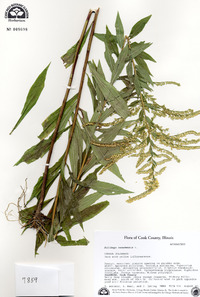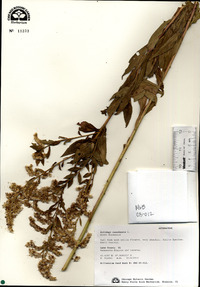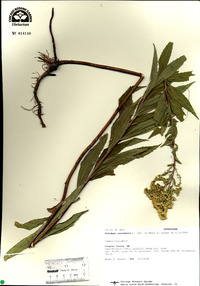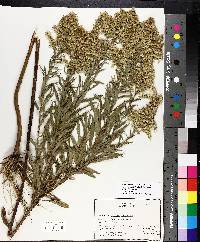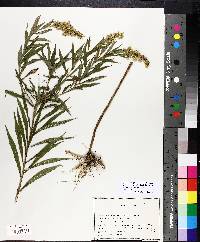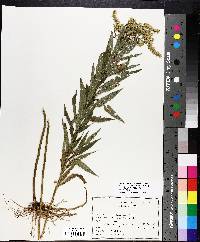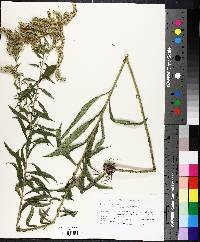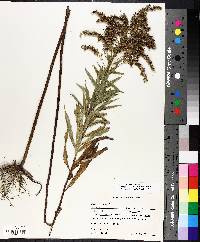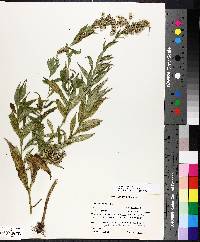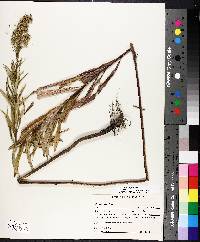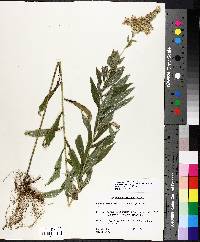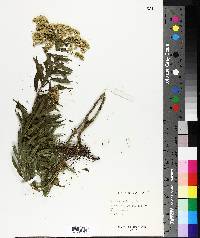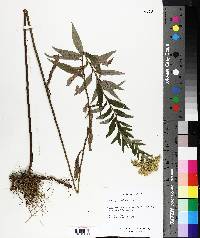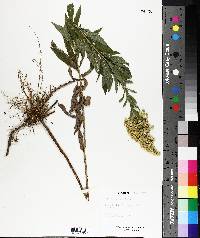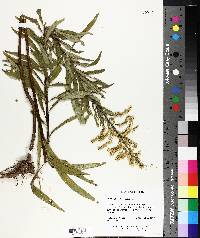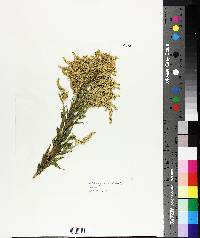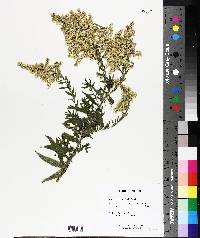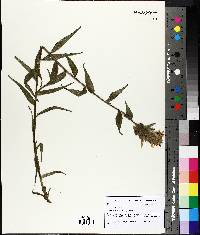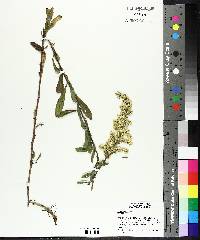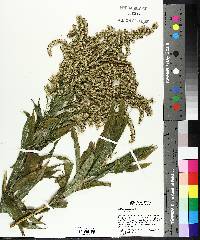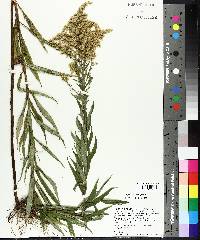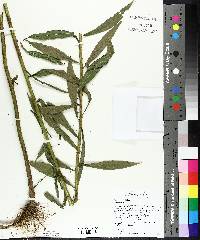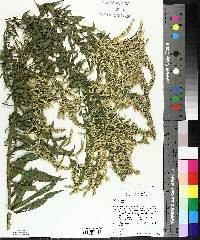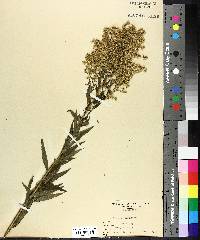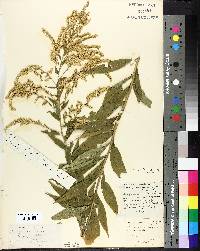Solidago canadensis
|
|
|
|
Family: Asteraceae
Canada goldenrod, more...Canadian Goldenrod, common goldenrod
[Solidago reflexa Aiton] |
Plants 30-150(-200) cm; rhizomes short to long creeping. Stems 1-20+, erect, glabrate proximally or sparsely strigoso-villous, becoming more densely so distal to mid stem. Leaves: basal 0; proximal to mid cauline usually withering by flowering, tapering to sessile bases, blades narrowly ovate-lanceolate, 50-190 × 5-30 mm, margins sharply serrate, 3-nerved, apices acuminate, abaxial faces glabrous or more commonly hairy along main nerves, adaxial glabrous or slightly scabrous; mid to distal similar, 30-50(-120) × 8-12 mm, largest near mid stem, reduced distally, margins usually serrate or serrulate (teeth 3-8), sometimes entire proximal to arrays. Heads (70-)150-1300+ , secund, in secund pyramidal-paniculiform arrays (obscurely so and club-shaped thyrsiform in small plants or shoots with small arrays), branches divergent and recurved, branches and peduncles hairy. Peduncles 3-3.4 mm, bracteoles 0-3, linear-triangular. Involucres narrowly campanulate, 1.7-2.5(-3) mm. Phyllaries in 3-4 series, strongly unequal, acute to obtuse; outer lanceolate, inner linear-lanceolate. Ray florets (5-)8-14(-18); laminae 0.5-1.5 × 0.15-0.3(-0.5) mm. Disc florets (2-)3-6(-8); corollas 2.2-2.8(-3) mm, lobes 0.4-0.8(-1) mm. Cypselae (narrowly obconic) 1-1.5 mm (ribbed), sparsely strigose; pappi 1.8-2.2 mm. Solidago canadensis is cultivated and introduced in more western states and in Europe. Very narrow limits for the species are followed here. Alternatively, the species has been defined broadly to include most other species of the subsection (e.g., A. Cronquist 1994). Solidago ×bartramiana Fernald [S. canadensis var. bartramiana (Fernald) Beaudry] is considered to be a hybrid between S. canadensis and S. uliginosa. Its growth form and array are more like those of the latter. Two sometimes difficult-to-distinguish varieties with greatly overlapping ranges are recognized.
FNA 2006, Kearney and Peebles 1969, McDougall 1973 Duration: Perennial Nativity: Native Lifeform: Forb/Herb General: Herbaceous perennials, to 150 cm tall, stems clustered or solitary, glabrous at the base, branches and peduncles hairy, the leaves numerous and crowded, plants with short to long-creeping rhizomes. Leaves: Alternate, sessile, lanceolate, 6-15 cm long and 5-18 mm wide, with long-acuminate tips, margins sharply serrate, glabrous or pubescent only on the veins beneath, evidently 3-nerved, reducing distally, basal leaves absent. Flowers: Heads small, radiate, rays yellow, minute, pistillate, disk flowers yellow, perfect, 2-3 mm long, involucres 2-3 mm high, narrowly campanulate, phyllaries linear, attenuate, thin and dry, yellow-green with small, green tips, unequal and overlapping in 3-4 series, heads in broad raceme or cymose panicles, often occurring mostly on one side of numerous, spreading and recurved branches. Fruits: Achenes 1-1.5 mm long, narrowly obconic, ribbed, and sparsely strigose. Pappus of capillary bristles, 1.8-2.2 mm long. Ecology: Found from 2,500-8,500 ft (762-2591 m); flowering July-October. Distribution: Newfoundland to Virginia, westward to Montana, Nevada, and Arizona. Ethnobotany: An infusion of the flowers was taken as an emetic for too much gall, diarrhea, body pains, flu, and the crushed blossoms were chewed for a sore throat, an infusion of shoots was given to children with fevers, a compound decoction was used as wash for children who do not talk or laugh, an infusion of the roots and flowers were used for side pains, as an emetic, given to babies that start suddenly during sleep, and to kill a love medicine, the plant was used to make a steam bath for crippled, paralyzed people, as a bath for babies with diarrhea, sleeplessness or excessive crying, and the plant was used for luck during gambling. The seeds were used for food, and the roots were steeped, eaten, or smoked with other tobaccos. Etymology: Solidago comes from Latin solido, meaning to make whole or heal, while canadensis means of or from Canada. Synonyms: None Editor: LCrumbacher 2011 Perennial, mostly with long, creeping rhizomes (rhizome short in var. gilvocanescens), 2.5-20 dm, the stem ±puberulent at least above the middle; lvs chiefly cauline, numerous, triple-nerved, lance-linear to lance-elliptic or narrowly elliptic, sessile, tapering to both ends, the larger ones 3-15 cm נ5-22 mm, puberulent at least on the midrib and main veins beneath; infl mostly paniculiform, with strongly recurved-secund branches (varying to thyrsoid and not secund in var. salebrosa); invol 2-4(-5) mm, its bracts imbricate, thin and slender, acute or acuminate, yellowish, without a well defined green tip; rays 10-17 (or fewer in var. hargeri), 1-3 mm; disk-fls 2-8 (to 13 in var. salebrosa); achenes short-hairy; 2n=18, 36, 54. Moist or dry open places and thin woods; throughout most of the U.S. and s. Can. Five vars. in our range: Gleason, Henry A. & Cronquist, Arthur J. 1991. Manual of vascular plants of northeastern United States and adjacent Canada. lxxv + 910 pp. ©The New York Botanical Garden. All rights reserved. Used by permission. |
|
|
|

